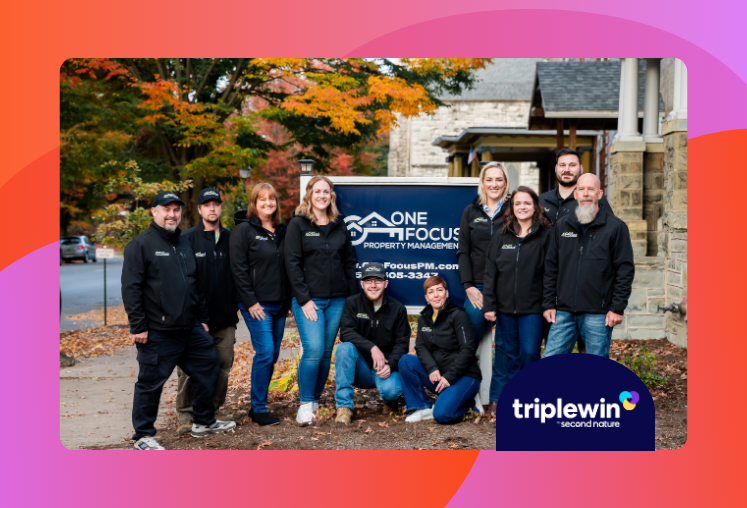Jennifer Ruelens is the broker/owner at One Focus Property Management, the largest property management company in North Central Pennsylvania. Jennifer has over twenty years of real estate experience, and 13 as broker/owner at One Focus. She also founded Hold It with PM Jen, a platform dedicated to helping investors grow wealth with the buy and hold real estate strategy. Jen is a Second Nature Triple Win Mentor.
Not too long ago, the hot new thing in property management was offering different service tiers, where the more a client paid, the more they got in their management package. I decided to give it a try, and through the process I learned a lot about myself and how I wanted to run my business.
The thing is, I didn’t want to build any kind of “less than” tier. In my view, if something is good for clients, it should be included in every plan that I offer. Otherwise, I’m just delivering some clients sub-par services.
That got me thinking about how I wanted to build out my different service levels, how I wanted to structure my business, and how to build a proven process that could allow me to step outside of my role as an executor to become more strategic.
Assuming risk with a “gold plan”
Because I didn’t want to offer a package that I didn’t think lived up to my values and my brand, I ultimately decided not to go with a good/better/best structure. Instead, I kept my standard management package and added what I called a Gold Plan.
The Gold Plan was built to offer all the same services as my standard package, but it also came with some pretty hefty guarantees. Basically, if you paid for Gold and you had losses, property damages, or unpaid rent because of a resident, we would cover that expense. The program was completely self-funded and self-insured, so the buck stopped with me.
On its face, this seemed like a pretty big risk for my business. Assuming financial responsibility for so many different things was a gamble, and plenty of people told me I was just asking for trouble. But the thing is, I knew my business, and I had the data to back it up. When I took a deep look at my company’s performance, it turned out I was losing less than 1% of receipts to bad debt, so the risk factor was actually very low compared to the additional management fees I was collecting with the Gold Plan.
Risk mitigation as a service
One of the biggest reasons that I chose to develop the Gold Plan wasn’t just because I felt that we could increase profit margins. Risk mitigation is actually of tremendous value to our investors. By building it into our go-to-market strategy as a defined service, it helped us better communicate that value.
Differentiating your property management business is really difficult. Most clients are so detached from the daily workings of property management that they don’t even know what to ask about. We have to do a lot of work just to educate them on what it is that we do, never mind all the value-adding activities they never see.
By packaging risk assumption as a unique product, it helped us better articulate our value and present a clearer go-to-market message.
Developing a proven process
What I didn’t foresee when I built out the Gold Plan and took on some of this risk was how my own role within the company would evolve. As we continued to grow, I had fewer direct touch points with my clients, and things became a little bit less predictable.
Working on my business, not in my business
It’s a story a lot of property managers can tell you: when you’re small you know every single client, but when you reach a certain level and you hire more staff, you’re less involved in the day-to-day and focused more on business strategy.
The problem in my case was that I had built a Gold Plan based on the idea that I could personally oversee the risk levels of all my clients and all of their properties. When I shifted into a more strategic role, that became increasingly difficult.
I no longer had eyes on every single interaction or every property inspection. I hired business development managers to bring on new clients, and suddenly I wasn’t intimately involved in every deal that came in. I realized that I needed to design a company that let me keep a handle on risk, and that’s when I developed our proven process.
Creating a need for a proven process
The proven process started with a few simple questions about making the company more efficient and keeping us out of crisis mode:
- How do we make sure that properties stay stable?
- How can we identify risk before it becomes a problem?
- How can we get properties back on track to a stabilized status?
We started by identifying what kinds of things actually indicated “risk”. What behaviors were indicators that there might be a growing problem? Things like:
- Code violations in a property
- Resident disputes (with us or with each other)
- Unpaid or consistently late rent
We started flagging every one of those behaviors as soon as it happened so that we could monitor and stabilize those properties. That quickly developed into an hour-long, weekly meeting where my staff reported out any red flags they were seeing, and then the whole property management team discussed ways to address them. I joined that meeting and basically role-played the world’s worst client, pressure testing every solution we proposed until we were confident in our go-forward plan.
That one hour a week let me keep my finger on the pulse of every potential problem across our portfolio without having to be deeply involved with every single resident every single day, and allowed me the time and space I needed to make strategic decisions about the business. It also let me see the inner workings of how my team was confronting problems, and gave me more confidence than ever that they were doing the right thing.
Moving beyond the Gold Plan
Ultimately, after a few years, I made the difficult choice to sunset our Gold Plan. While it was a great program for us, it didn’t come without challenges. When I was acting as a BDM and directly involved in every single deal, I had a natural intuition for which clients I should sell Gold Plan to. Once I hired other BDMs, they didn’t have that same instinct, and, as a result, we started selling Gold Plan to accounts that weren’t a great fit for it. And those accounts started costing me.
The Gold Plan was successful while it lasted. I didn’t get wiped out by any disasters, and I did make a profit. But the potential future risk to my business meant that, as a leader, I had to protect myself and my staff, and quit while I was ahead.
I’m still looking at ways to relaunch a similar plan, this time supported by a third party insurer. In the meantime, I’m still utilizing the proven process that we developed, and it’s still incredibly effective in helping me manage clients, residents, and staff without having to be constantly in the trenches. If that were the only result to come out of the Gold Plan, it would be 100% worth it. I learned a lot, and I’m glad I took a chance.
Final thoughts
To me, there are a few lessons that any property manager should take from this experiment.
- Be deliberate about how you build service packages. You should put very clear, specific thought into how to build service packages that work for your business. Don’t just think about how profitable they’ll be or how well they’ll sell, but consider how they’ll change your team structure, the way you work with your staff, and what will be required of you as a business leader.
- Make your service levels scalable. As your company grows, your role will continue to evolve. You can’t be directly involved with every client, and you need to trust your team. Make sure you’re offering management packages that allow you to do that.
- Use service tiers to communicate your value. The various packages that you offer to investors can be a fantastic tool to help show exactly what it is that you do. You don’t want clients wondering what they’re getting in exchange for their management fees. Client education never ends, so embed it into your process.
- Don’t be afraid to pivot. You should always be thoughtful when you try new things. I had data to justify the Gold Plan. I didn’t just start selling it on a whim. But as things changed, I realized it was no longer right for my company. Don’t be afraid to change things if they’re no longer working.
Everyone’s business is different, and every business leader takes their own approach. But with each business decision you make, you should always be on the lookout for ways to improve the processes around it.
If you want to hear more about how I approach my company and my property management philosophy, listen to my recent episode of the Triple Win Podcast.
Topics:




